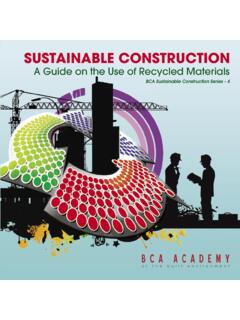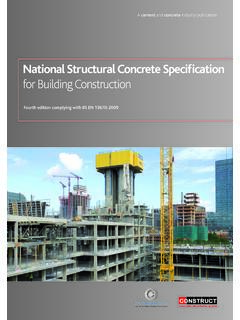Transcription of Precast Concrete Floors in Steel Framed Buildings
1 June 2018 Precast Concrete Floors in Steel Framed Buildings Precast Concrete Floors in Steel Framed Buildings i CONTENTS 1 INTRODUCTION 1 2 SLAB DESIGN 1 End Preparation of Hollowcore Planks 2 Minimum Bearing 3 Allowance for Non-Rigid Supports 4 Diaphragm Action 5 Shear resistance of grouted joints 5 Perimeter reinforcement at floor edges 6 Beam transverse reinforcement 6 Fire Resistance 7 3 BEAM DESIGN 8 Practical Considerations 8 Minimum beam width 8 Edge beams 9 Beam Design Construction Stage 9 Beam Design Normal Stage 11 Shear studs 12 Effective flange width 12 Longitudinal shear and transverse reinforcement 13 Bending resistance 13 Serviceability conditions 14 4 DISPROPORTIONATE COLLAPSE 15 Introduction 15 Design Aspects 16 Typical Details for Hollowcore Floors 17 GLOSSARY 19 REFERENCES 20 FURTHER READING 21 The contents of this technical guidance document formed the basis of three technical articles which were published in the April, May and June editions of The Structural Engineer in 2018.
2 Precast Concrete Floors in Steel Framed Buildings 1 1 INTRODUCTION In the UK Steel - Framed Buildings with Precast Concrete Floors are a common form of multi-storey building. Such structures may be used for car parking, for commercial, retail or residential property developments and for public Buildings , such as schools and hospitals. This hybrid form of construction has many benefits to it, including the provision of an early, secure and broad platform from which subsequent site activities can be undertaken. This technical guidance document addresses aspects of designing Steel Framed Buildings with Precast Concrete Floors .
3 2 SLAB DESIGN The design of Precast prestressed Concrete planks (see Figure ) will usually be undertaken by the manufacturer in consultation with the frame designer, who will need to specify the design floor loading. The major design issues with respect to load capacity are briefly discussed below: (i) Unlike a conventionally reinforced Precast Concrete element, the only reinforcement in a prestressed plank comprises longitudinal prestressing tendons, which are anchored by bonding with the Concrete as it cures. Since the majority (often all) of the tendons are concentrated in the lower half of a plank, Floors will usually be designed to be simply supported in order to avoid tensile stresses in the top of the plank.
4 (ii) The bending resistance of a Precast prestressed plank is determined in a similar manner to that of any prestressed Concrete element. The British Precast document CCIP-034 Precast Eurocode 2: Worked Examples [1] contains a detailed example of the design of a hollowcore plank. (iii) The shear resistance of a Precast prestressed plank is determined in a similar manner to that of a conventionally reinforced Concrete one-way spanning slab. The reader is again referred to the British Precast document CCIP-034 Precast Eurocode 2: Worked Examples for information about designing hollowcore planks for shear. Additionally, the manufacturer will perform design checks in the vicinity of the supports, such as: (a) shear tension failure, which occurs when the principal tensile stress in the web of a hollowcore plank reaches the tensile strength of the Concrete ; (b) sufficient anchorage of the prestressing tendon, and (c) the effects of non-rigid supports.
5 The checks for (a) and (b) are strongly affected by the length from the support over which the full prestressing force is developed (known as the transmission length ). (iv) The use of a structural topping on Precast prestressed planks enhances the structural capacity of the floor due to composite action between the topping and the planks. Typically, a structural topping comprises a 75 mm thick layer of C25/30 normal weight Concrete reinforced with fabric reinforcement. This structural topping should not be confused with some types of screed that do not contribute any structural enhancement to the Precast Concrete planks.
6 The design of the topping must take into account: (a) compressive stress in the topping; (b) horizontal (complementary) shear at the interface between the topping and the floor planks; (c) durability requirements of the Concrete , and (d) cracking of the topping due to shrinkage and thermal movement during and after construction. Precast Concrete Floors in Steel Framed Buildings 2 Steel Construction Institute (SCI) Report P401 [2] indicates that if a structural topping is used, then typically it is possible to increase the resistance of hollowcore planks by between 20% and 60%. Figure Examples of Precast hollowcore flooring The requirement for floor diaphragm action also needs to be considered when designing Precast prestressed Concrete Floors .
7 Although there is usually no mechanical fixing between structural topping and Precast planks, the two parts can be designed to act compositely provided that the shear stress at the interface meets the requirements of clause of bs en 1992-1-1 [3]. Consequently, the reinforcement in the structural topping must be designed for both bending and diaphragm actions. Clause of bs en 1992-1-1 explains the principles of how a Precast floor can be designed to act as a diaphragm. End Preparation of Hollowcore Planks The ends of what would otherwise be standard square-ended planks can be modified during the manufacturing process to facilitate the installation of the planks and the provision of ties.
8 For example, it is sometimes difficult to install planks onto their supports and so to counter this the ends of the planks can be chamfered or notched (see Figure ). For Precast Concrete planks less than 300 mm deep typical dimensions for a chamfer comprise a horizontal length of 235 mm and a maximum reduction in unit depth of 85 mm. For deeper Precast Concrete planks square notches are often used. When designing the notch or chamfer the manufacturer will also check that, in the vicinity of a support, there is sufficient slab remaining to resist any vertical shear forces that may be applied during construction (including those due to the weight of any topping).
9 Figure Chamfered and notched ends a) unit < 300 mm deep b) unit > 300 mm deep Another example is where the planks need to be tied to the support beams to satisfy disproportionate collapse requirements. The tops of a number of cores (between two and four) Precast hollowcore plank Grout Hollow core Tendon Structural topping Reinforcement 150 mm 100 mm 235 mm 85 mm Precast Concrete Floors in Steel Framed Buildings 3 can be opened up so that reinforcement may be placed within them (see Figure ). Generally, two adjacent cores should not be opened up, as it will be difficult to preserve the integrity of the chamfered rib between them.
10 Similarly, an outer core should not be opened up since the outer rib would become vulnerable to damage during handling and erection. Figure Section through Precast Concrete planks showing tie reinforcement in the cores During end preparation the void at the back of each opened core is blocked with Concrete and a weephole formed to allow any water that enters the unit to drain away (see Figure ). Figure Longitudinal section through an opened core Minimum Bearing SCI Report P401 identifies four factors affecting the actual size of the end bearing for Precast planks sitting on a Steel beam, namely: the nominal bearing length; variations in the size and position of the steelwork; length variations in the manufacture of the planks, and the accuracy with which the planks can be positioned on site.




